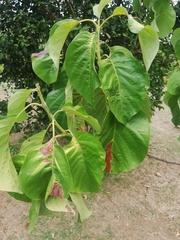

|
|
|
|
Family: Lauraceae
Avocado, more... (es: Aguacate, avocado, avocate)
|
Description: Alien. A small or medium-sized tree, often with irregular trunk branched near the ground, but sometimes straight and tall. Leaves are large, especially on young plants, oval, with a rounded tip, bluish on the underside, with few, widely-spaced secondary veins. When crushed, leaves smell weakly, although distinctly, like avocado. Reproduction: Flowers are small, cream-colored, produced in clusters in the second half of the wet season. Fruits, the familiar smooth-skinned, green avocado, develop during the dry season and mature at the start of the wet season. Distribution: In towns and farms throughout Panama. Occasionally there are individuals in the forest, probably only where farms were abandoned. Similar Species: The large, rounded leaves, with a bluish underside and weak avocado smell must learned to know trees without fruit. In towns and farmland, there are not other species like it. The rare forest tree can easily be missed unless you become familiar with the leaf. Uses: Fruits are sold widely in Panama. Descripción: Árbol de 10 a 35 m de alto. Copa con follaje denso. Tronco ramificado a baja o mediana altura. Corteza exterior negra o gris, internamente es aromática. Ramitas terminales verdes. Hojas simples y alternas, de 10-25 x 5-10 cm, elípticas a oblongas, con ápice acuminado, agudo a obtuso, bordes enteros a ondulados y base aguda, obtusa o redondeada. Las hojas a veces presentan el envés ligeramente gris. Pecíolo de 2-5 cm de largo y ligeramente acanalado en la parte superior. Flores verdes o amarillentas, aromáticas. Frutos en drupas, de 5-15 cm de largo, redondeados o en forma de peras, verdes, tornándose negros al madurar. Datos Ecológicos: La especie crece a bajas y medianas elevaciones, en lugares secos, húmedos o muy húmedos. Se encuentra como árbol cultivado en muchos lugares de Panamá. A veces deja caer sus hojas durante la temporada de floración. Florece y fructifica de enero a julio. Las flores son visitadas por abejas y otros insectos. Especies Parecidas: Por la forma de los frutos se puede confundir con plantas del género Capparis y LK capppi Preslianthus pittieri LK2 , pero en Capparis y P. pittieri los frutos cuelgan de un pedúnculo largo que tiene los restos del ginóforo de la flor. Usos: La pulpa de los frutos maduros es comestible. Se come crudo, en sopas y ensaladas. Se emplea para fabricar helados y dulces. Es rico en vitamina B2, A y E, también contiene azúcar, almidón y grasas. Cultivated at the Laboratory Clearing and rarely encountered in the forest, presumably persisting from old settlement sites. Flowers mostly in the early dry season. The fruits mature in the early rainy season. Bocas Species Database Habitat: The avocado will be found in low, middle or high altitudes, depending on the variety. This tree will often be found on hillsides. Distribution: The avocado tree has been reported from various countries such as Spain, South Africa, Peru, the United States, Central America, China, Australia, Sri Lanka and Viet Nam. Natural History Notes: Persea Americana has a long tradition of cultivation in Central and South America, from where it is native. Evidences have shown that Avocado was cultivated 10,000 years ago. The word “avocado” comes from the Nahuatl (dialect used by Aztecs) word “āhuacatl”, which means testicle because of the shape of the fruit. This tree needs full sun to be productive and requires a good space between each tree because the roots are highly competitive. Avocado trees prefer loose, decomposed, granite or sandy loam soils, but more importantly they need to be on a well-drained soil. A single avocado tree can produce up to 120 fruits annually and the fruit will mature on the tree but will ripe off the tree. For commercial purposes, avocados are usually collected hard and green and are kept at low temperatures to facilitate their transportation. Then, the fruits are placed in a gas chamber full of ethylene, a gas that stimulates ripening, and are then ready to be placed on shelves of any supermarket around the world. Characteristics: The avocado tree has short roots. A tree can contain thousands of inflorescences, where each carries hundreds of flowers. A flower is green and shows three whorls of three stamens and an ovary. Each flower will open twice and will remain closed in between and the first time it opens it will function as a female and the second time as a male. This ingenious mechanism helps to prevent self-pollination. There are three ecological races that are recognized: Mexican, Guatemala and West Indian, which mainly refer to the place where they are cultivated: subtropical, semi-tropical and tropical, respectively. The fruit avocado has an oval shape and a fairly thick skin that is green before maturity, becoming dark purple as it ripens. The flesh inside is creamy and not sweet and we can see the large brown seed in the middle. The avocado fruit is rich in monounsaturated fat, but also has a high content of potassium and vitamins B, K and E. |




































































































